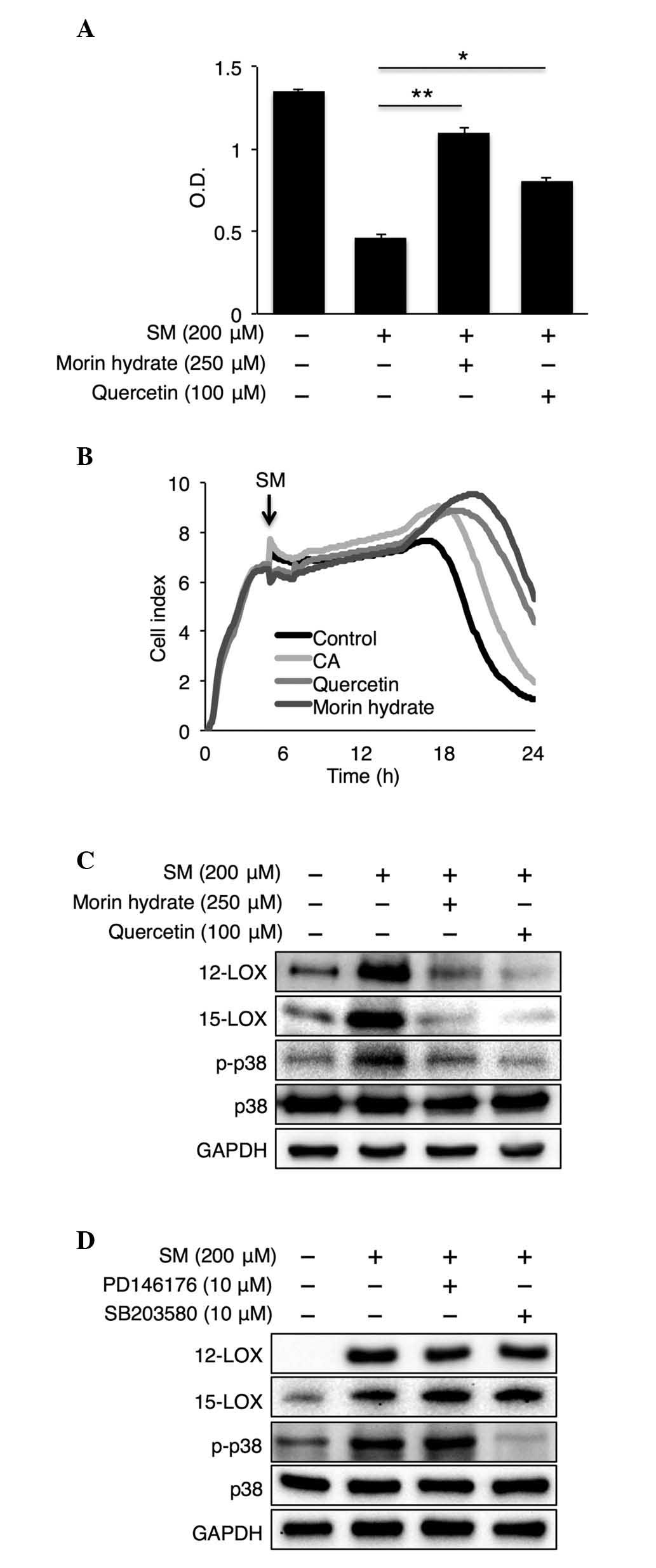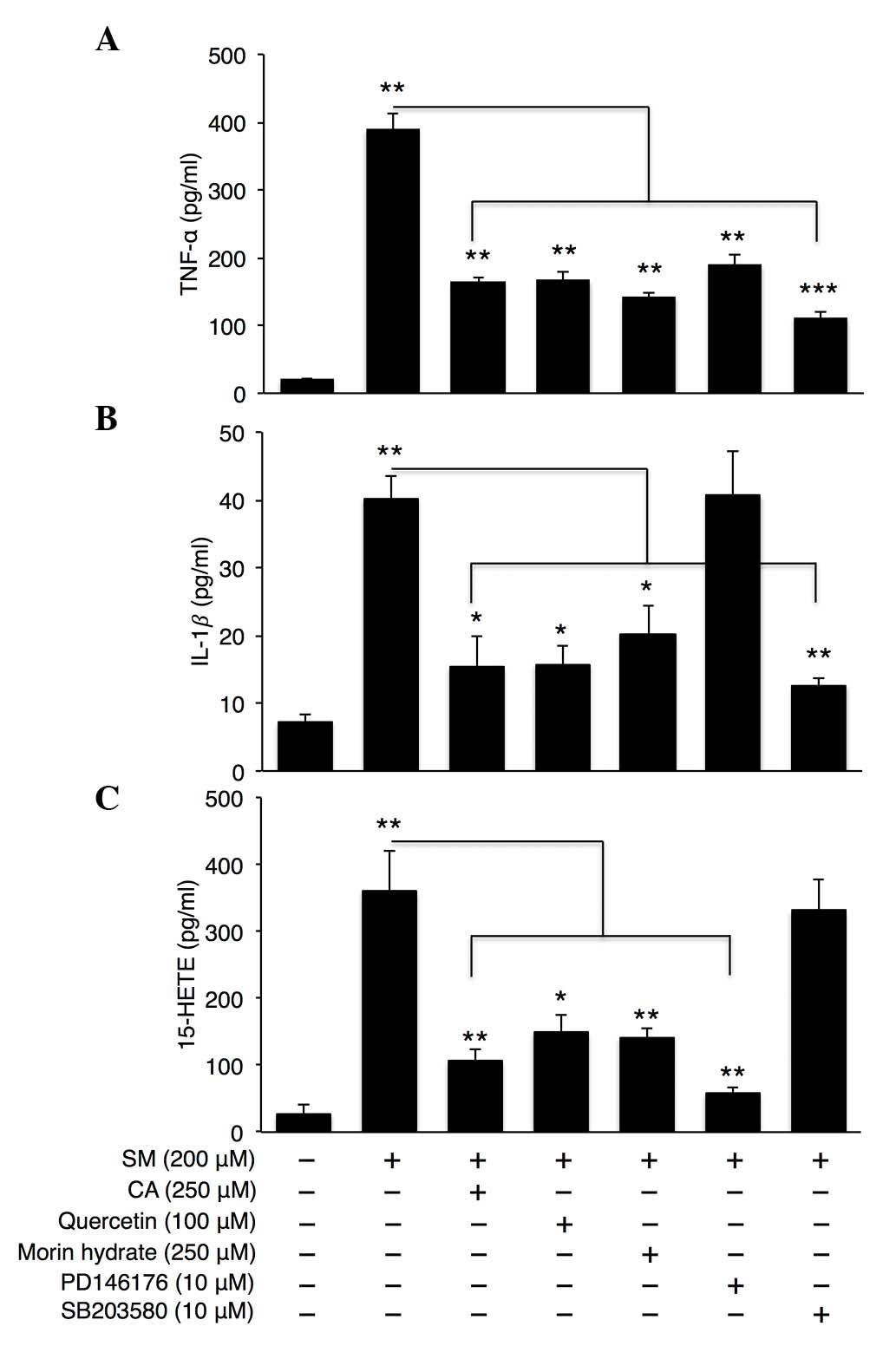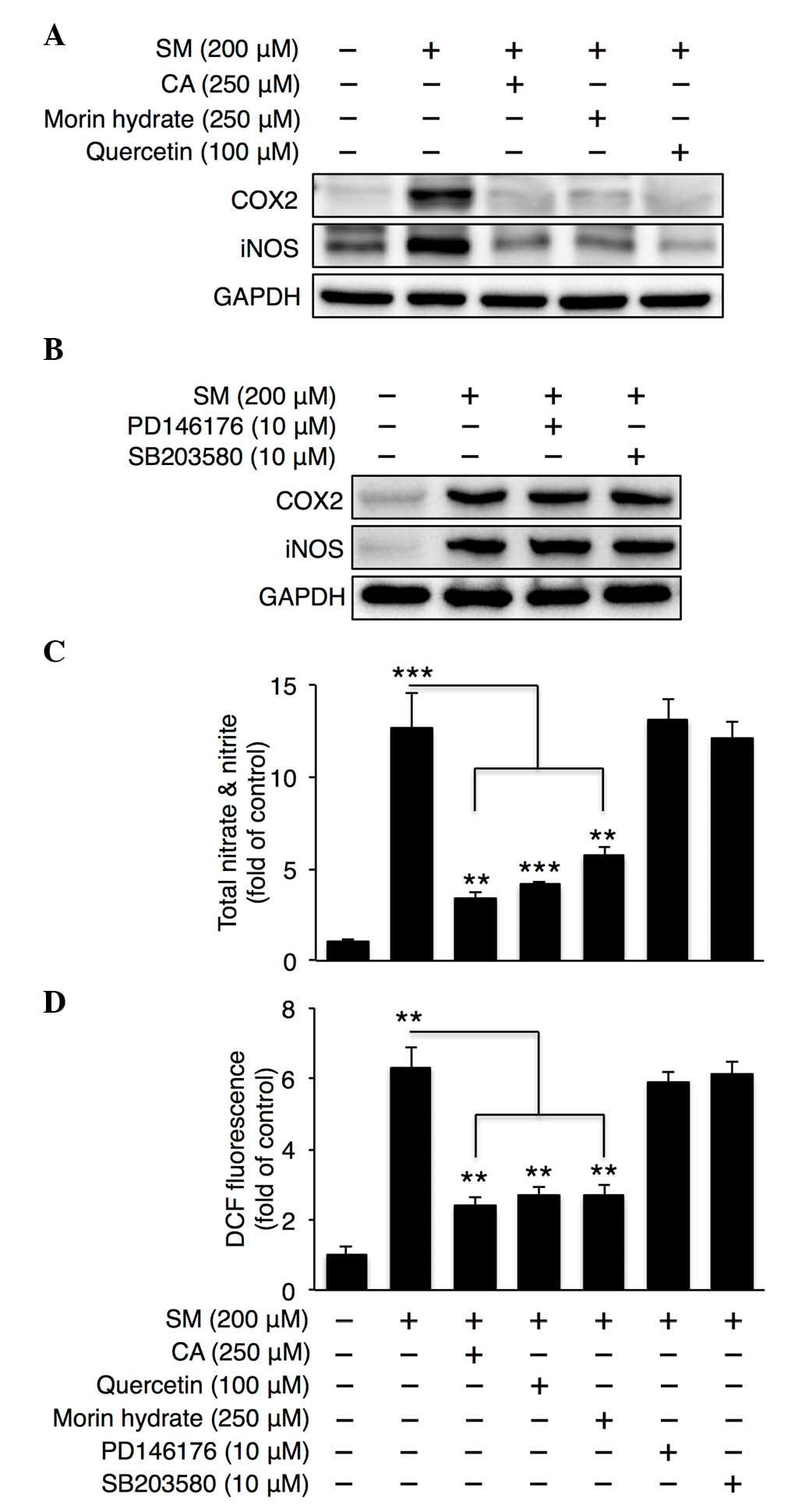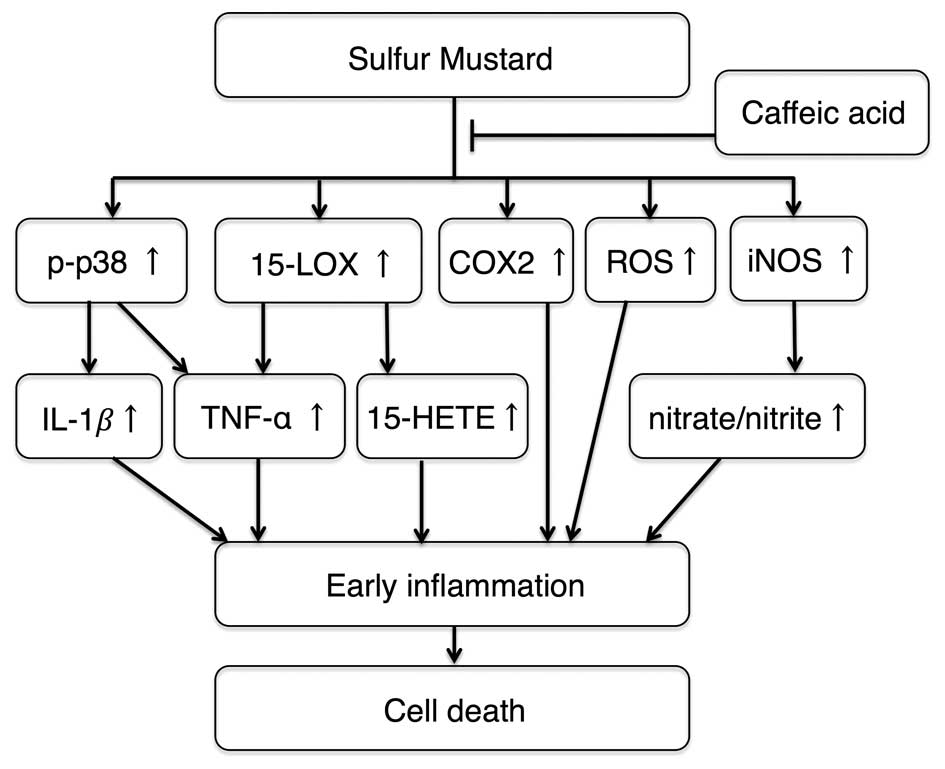|
1
|
Kehe K, Balszuweit F, Steinritz D and
Thiermann H: Molecular toxicology of sulfur mustard-induced
cutaneous inflammation and blistering. Toxicology. 263:12–19. 2009.
View Article : Google Scholar : PubMed/NCBI
|
|
2
|
Ries C, Popp T, Egea V, Kehe K and Jochum
M: Matrix metalloproteinase-9 expression and release from skin
fibroblasts interacting with keratinocytes: Upregulation in
response to sulphur mustard. Toxicology. 263:26–31. 2009.
View Article : Google Scholar : PubMed/NCBI
|
|
3
|
McClintock SD, Hoesel LM, Das SK, Till GO,
Neff T, Kunkel RG, Smith MG and Ward PA: Attenuation of half sulfur
mustard gas-induced acute lung injury in rats. J Appl Toxicol.
26:126–131. 2006. View
Article : Google Scholar : PubMed/NCBI
|
|
4
|
Kehe K, Raithel K, Kreppel H, Jochum M,
Worek F and Thiermann H: Inhibition of poly (ADP-ribose) polymerase
(PARP) influences the mode of sulfur mustard (SM)-induced cell
death in HaCaT cells. Arch Toxicol. 82:461–470. 2008. View Article : Google Scholar : PubMed/NCBI
|
|
5
|
Simbulan-Rosenthal CM, Ray R, Benton B,
Soeda E, Daher A, Anderson D, Smith WJ and Rosenthal DS: Calmodulin
mediates sulfur mustard toxicity in human keratinocytes.
Toxicology. 227:21–35. 2006. View Article : Google Scholar : PubMed/NCBI
|
|
6
|
Dillman JF III, McGary KL and Schlager JJ:
An inhibitor of p38 MAP kinase downregulates cytokine release
induced by sulfur mustard exposure in human epidermal
keratinocytes. Toxicol In Vitro. 18:593–599. 2004. View Article : Google Scholar : PubMed/NCBI
|
|
7
|
Rebholz B, Kehe K, Ruzicka T and Rupec RA:
Role of NF-kappaB/RelA and MAPK pathways in keratinocytes in
response to sulfur mustard. J Invest Dermatol. 128:1626–1632. 2008.
View Article : Google Scholar : PubMed/NCBI
|
|
8
|
Pal A, Tewari-Singh N, Gu M, Agarwal C,
Huang J, Day BJ, White CW and Agarwal R: Sulfur mustard analog
induces oxidative stress and activates signaling cascades in the
skin of SKH-1 hairless mice. Free Radic Biol Med. 47:1640–1651.
2009. View Article : Google Scholar : PubMed/NCBI
|
|
9
|
Paromov V, Suntres Z, Smith M and Stone
WL: Sulfur mustard toxicity following dermal exposure: Role of
oxidative stress and antioxidant therapy. J Burns Wounds.
7:e72007.PubMed/NCBI
|
|
10
|
Kumar O, Sugendran K and Vijayaraghavan R:
Protective effect of various antioxidants on the toxicity of
sulphur mustard administered to mice by inhalation or percutaneous
routes. Chem Biol Interact. 134:1–12. 2001. View Article : Google Scholar : PubMed/NCBI
|
|
11
|
Naghii MR: Sulfur mustard intoxication,
oxidative stress, and antioxidants. Mil Med. 167:573–575.
2002.PubMed/NCBI
|
|
12
|
Gamaro GD, Suyenaga E, Borsoi M, Lermen J,
Pereira P and Ardenghi P: Effect of rosmarinic and caffeic acids on
inflammatory and nociception process in rats. ISRN Pharmacol.
2011:4516822011. View Article : Google Scholar : PubMed/NCBI
|
|
13
|
Natarajan K, Singh S, Burke TR Jr,
Grunberger D and Aggarwal BB: Caffeic acid phenethyl ester is a
potent and specific inhibitor of activation of nuclear
transcription factor NF-kappa B. Proc Natl Acad Sci USA.
93:9090–9095. 1996. View Article : Google Scholar : PubMed/NCBI
|
|
14
|
Sud'ina GF, Mirzoeva OK, Pushkareva MA,
Korshunova GA, Sumbatyan NV and Varfolomeev SD: Caffeic acid
phenethyl ester as a lipoxygenase inhibitor with antioxidant
properties. FEBS Lett. 329:21–24. 1993. View Article : Google Scholar : PubMed/NCBI
|
|
15
|
Sultana B and Anwar F: Flavonols
(kaempeferol, quercetin, myricetin) contents of selected fruits,
vegetables and medicinal plants. Food Chem. 108:879–884. 2008.
View Article : Google Scholar : PubMed/NCBI
|
|
16
|
Rattanachaikunsopon P and Phumkhachorn P:
Bacteriostatic effect of flavonoids isolated from leaves of Psidium
guajava on fish pathogens. Fitoterapia. 78:434–436. 2007.
View Article : Google Scholar : PubMed/NCBI
|
|
17
|
Brash AR: Lipoxygenases: Occurrence,
functions, catalysis, and acquisition of substrate. J Biol Chem.
274:23679–23682. 1999. View Article : Google Scholar : PubMed/NCBI
|
|
18
|
Minsavage GD and Dillman JF III:
Bifunctional alkylating agent-induced p53 and nonclassical nuclear
factor kappaB responses and cell death are altered by caffeic acid
phenethyl ester: A potential role for antioxidant/electrophilic
response-element signaling. J Pharmacol Exp Ther. 321:202–212.
2007. View Article : Google Scholar : PubMed/NCBI
|
|
19
|
Sadik CD, Sies H and Schewe T: Inhibition
of 15-lipoxygenases by flavonoids: Structure-activity relations and
mode of action. Biochem Pharmacol. 65:773–781. 2003. View Article : Google Scholar : PubMed/NCBI
|
|
20
|
Black AT, Joseph LB, Casillas RP, Heck DE,
Gerecke DR, Sinko PJ, Laskin DL and Laskin JD: Role of MAP kinases
in regulating expression of antioxidants and inflammatory mediators
in mouse keratinocytes following exposure to the half mustard,
2-chloroethyl ethyl sulfide. Toxicol Appl Pharmacol. 245:352–360.
2010. View Article : Google Scholar : PubMed/NCBI
|
|
21
|
Lefkowitz LJ and Smith WJ: Sulfur
mustard-induced arachidonic acid release is mediated by
phospholipase D in human keratinocytes. Biochem Biophys Res Commun.
295:1062–1067. 2002. View Article : Google Scholar : PubMed/NCBI
|
|
22
|
Gerecke DR, Chen M, Isukapalli SS, Gordon
MK, Chang YC, Tong W, Androulakis IP and Georgopoulos PG:
Differential gene expression profiling of mouse skin after sulfur
mustard exposure: Extended time response and inhibitor effect.
Toxicol Appl Pharmacol. 234:156–165. 2009. View Article : Google Scholar : PubMed/NCBI
|
|
23
|
Folco G and Murphy RC: Eicosanoid
transcellular biosynthesis: From cell-cell interactions to in vivo
tissue responses. Pharmacol Rev. 58:375–388. 2006. View Article : Google Scholar : PubMed/NCBI
|
|
24
|
Seiler A, Schneider M, Förster H, Roth S,
Wirth EK, Culmsee C, Plesnila N, Kremmer E, Rådmark O, Wurst W, et
al: Glutathione peroxidase 4 senses and translates oxidative stress
into 12/15-lipoxygenase dependent- and AIF-mediated cell death.
Cell Metab. 8:237–248. 2008. View Article : Google Scholar : PubMed/NCBI
|
|
25
|
Gu J, Liu Y, Wen Y, Natarajan R, Lanting L
and Nadler JL: Evidence that increased 12-lipoxygenase activity
induces apoptosis in fibroblasts. J Cell Physiol. 186:357–365.
2001. View Article : Google Scholar : PubMed/NCBI
|
|
26
|
Wang H, Li J, Follett PL, Zhang Y,
Cotanche DA, Jensen FE, Volpe JJ and Rosenberg PA: 12-Lipoxygenase
plays a key role in cell death caused by glutathione depletion and
arachidonic acid in rat oligodendrocytes. Eur J Neurosci.
20:2049–2058. 2004. View Article : Google Scholar : PubMed/NCBI
|
|
27
|
Li Y, Maher P and Schubert D: A role for
12-lipoxygenase in nerve cell death caused by glutathione
depletion. Neuron. 19:453–463. 1997. View Article : Google Scholar : PubMed/NCBI
|
|
28
|
Martínez-Clemente M, Ferré N,
González-Périz A, López-Parra M, Horrillo R, Titos E,
Morán-Salvador E, Miquel R, Arroyo V, Funk CD and Clària J:
5-lipoxygenase deficiency reduces hepatic inflammation and tumor
necrosis factor alpha-induced hepatocyte damage in
hyperlipidemia-prone ApoE-null mice. Hepatology. 51:817–827. 2010.
View Article : Google Scholar : PubMed/NCBI
|
|
29
|
Wen Y, Gu J, Chakrabarti SK, Aylor K,
Marshall J, Takahashi Y, Yoshimoto T and Nadler JL: The role of
12/15-lipoxygenase in the expression of interleukin-6 and tumor
necrosis factor-alpha in macrophages. Endocrinology. 148:1313–1322.
2007. View Article : Google Scholar : PubMed/NCBI
|
|
30
|
Schade UF, Ernst M, Reinke M and Wolter
DT: Lipoxygenase inhibitors suppress formation of tumor necrosis
factor in vitro and in vivo. Biochem Biophys Res Commun.
159:748–754. 1989. View Article : Google Scholar : PubMed/NCBI
|
|
31
|
Zhang R, Kang KA, Piao MJ, Maeng YH, Lee
KH, Chang WY, You HJ, Kim JS, Kang SS and Hyun JW: Cellular
protection of morin against the oxidative stress induced by
hydrogen peroxide. Chem Biol Interact. 177:21–27. 2009. View Article : Google Scholar : PubMed/NCBI
|
|
32
|
Dugas AJ, Castañeda-Acosta J, Bonin GC,
Price KL, Fischer NH and Winston GW: Evaluation of the total
peroxyl radical-scavenging capacity of flavonoids:
Structure-activity relationships. J Nat Prod. 63:327–331. 2000.
View Article : Google Scholar : PubMed/NCBI
|
|
33
|
Chen YJ, Shiao MS and Wang SY: The
antioxidant caffeic acid phenethyl ester induces apoptosis
associated with selective scavenging of hydrogen peroxide in human
leukemic HL-60 cells. Anticancer Drugs. 12:143–149. 2001.
View Article : Google Scholar : PubMed/NCBI
|
|
34
|
Choi K and Choi C: Differential regulation
of c-Jun N-terminal kinase and NF-kappaB pathway by caffeic acid
phenethyl ester in astroglial and monocytic cells. J Neurochem.
105:557–564. 2008. View Article : Google Scholar : PubMed/NCBI
|















